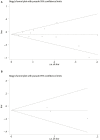Aspirin Use on Incident Dementia and Mild Cognitive Decline: A Systematic Review and Meta-Analysis
- PMID: 33613260
- PMCID: PMC7890199
- DOI: 10.3389/fnagi.2020.578071
Aspirin Use on Incident Dementia and Mild Cognitive Decline: A Systematic Review and Meta-Analysis
Abstract
Background: More people with cognitive dysfunction and dementia also fall into the category of high vascular risk, for which aspirin is one of the most frequently used drugs. However, previous studies reporting that aspirin buffers against mild cognitive decline (MCI) and dementia remain controversial. We thus conducted an updated systematic review and meta-analysis to evaluate the association of aspirin use with the risk of MCI and dementia in older adults. Methods: Data sources from PubMed, Embase, Web of Science, and the Cochrane Database for randomized controlled trails (RCTs) and cohort studies (published between January 1, 2000 and April 11, 2020). Relative risks (RRs) and 95% confidence intervals (95% CIs) were used to pool data on the occurrence of dementia and MCI with random-effects models. Results: Of 3,193 identified articles, 15 studies (12 cohort studies and three RCTs) were eligible and were included in our analysis, which involved a total of 100,909 participants without cognitive dysfunctions or dementia at baseline. In pooled cohort studies, aspirin use did not reduce the incidence of MCI and dementia (the pooled RR = 0.97; 95% CI = 0.85-1.11; = 65%) compared with non-users. However, low-dose aspirin (75-100 mg/day) was associated with a decreased likelihood of developing dementia or MCI (the pooled RR = 0.75; 95% CI = 0.63-0.9; = 50.5%). This association existed in studies including all-cause dementia (the pooled RR = 0.82; 95% CI = 0.71-0.96) and Alzheimer's disease (AD) (the pooled RR = 0.54; 95% CI = 0.33-0.89), but not in MCI (the pooled RR = 0.58; 95% CI = 0.31-1.08). In RCTs, low-dose aspirin use was not significantly associated with less prevalence of dementia or MCI (RR = 0.94; 95% CI = 0.84-1.05; = 0.0%). Conclusions: In cohort studies, we found that low-dose aspirin use had a higher likelihood of reducing the incidence of dementia, which was not supported by RCTs. The evidence was insufficient to fully evaluate the effect of aspirin on cognitive function and dementia. Well-designed studies and innovative approaches are therefore needed to clarify whether the use of aspirin improves cognitive function and reduces the risk of dementia.
Keywords: aspirin; association; dementia; meta-analysis; mild cognitive decline.
Copyright © 2021 Li, Li, Zhang, Ma and Zhang.
Conflict of interest statement
The authors declare that the research was conducted in the absence of any commercial or financial relationships that could be construed as a potential conflict of interest.
Figures





References
-
- Adami H. O., Hunter D., Trichopoulos D. (2008). Textbook of Cancer Epidemiology. New York, NY: Oxford University Press; 10.1093/acprof:oso/9780195311174.001.0001 - DOI
-
- Aihw (2012). Improving Dementia Data in Australia: Supplement to Dementia in Australia 2012. Available online at: https://www.aihw.gov.au/reports/dementia/improving-dementia-data-in-aust... (accessed February 18, 2020).
Publication types
LinkOut - more resources
Full Text Sources
Other Literature Sources
Miscellaneous

